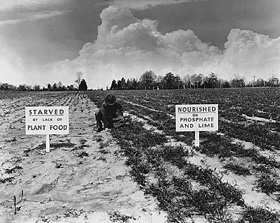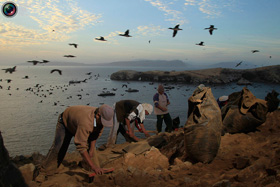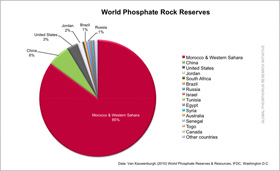Phosphorus as the Strategic Natural Resource of the 21st Century
(no votes) |
(0 votes) |
Doctor of physics and mathematics, Expert in scientific research commercialization
Branded as “an element of life and thought” by Russian Academician A. Fersman, phosphorus is an indispensable element of life on earth. The dwindling of the natural reserves of phosphate ores, observed for the first time ever at the turn of this millennium, presents a strategic challenge and lies at the root of the looming global food crisis and related international conflicts.
Branded as “an element of life and thought” by Russian Academician A. Fersman, phosphorus is an indispensable element of life on earth. The dwindling of the natural reserves of phosphate ores, observed for the first time ever at the turn of this millennium, presents a strategic challenge and lies at the root of the looming global food crisis and related international conflicts.
History repeats itself: food security
The new century is witnessing a growing conflict between two opposing civilizational trends: the higher consumption of key life-supporting factors (energy, food and water) on the one hand, and declining available reserves, on the other. Rising inequality in economic development between countries and continents allows for priority access for a relatively small minority of people on this planet to dwindling natural resources. The priority is sought by all available means – political, economic and military.
Food scarcity has for centuries served as a natural constraint on population growth as well as on urbanization and, as a consequence, industrial development. Until the mid-19th century, the efficiency of arable farming remained virtually unchanged, having been based on many centuries of land use experience. The growing urban population spelled the need for ever larger crop areas and the cultivation of more remote lands to produce more food. This raised even more issues, such as protecting cultivated lands, crop harvesting and delivering agricultural goods to towns. Food production costs mounted, occasionally giving rise to riots spurred by mass hunger. In this regard, low land productivity limited social equality and economic growth.
The problem of food security centered on the resolution of this conflict between civilization growth and the limited productivity of arable land.
Rising inequality in economic development between countries and continents allows for priority access for a relatively small minority of people on this planet to dwindling natural resources. The priority is sought by all available means – political, economic and military.
A solution appeared to have been ostensibly found in 1840 when a German chemist, Justus von Liebig, discovered the ‘magic triad’ of fertilisers: phosphorus, potassium and nitrogen. Introduced into the soil to compliment the organic nutrients already present in it, these fertilisers helped to drastically improve soil productivity; this marked the beginning of the “green revolution”. The discovery by von Liebig, in a simplified form, became an agrochemical axiom for the next century and a half: “the more mineral fertilisers, the bigger the harvest”. At the time, experts ignored questions related to both the limited natural resources of these minerals (in particular, phosphorus) and the possible negative consequences with which the “green revolution” was fraught, as revolutions do.
Von Liebig’s Recipe: panacea or euphoria?
The green revolution discoveries initially helped to significantly improve soil fertility and crop yields within fairly limited areas. Supported by a rapidly growing fertiliser industry, this research appeared to offer a global panacea. Apart from the periods during the world wars and the recession during the 1930s, intensive farming continued to make food available at lower prices to an ever growing number of people. Once restrained by meager harvests, now a rapid growth of population ensued. From 1965 until just recently, the world population increased from 3.2 billion to 7 billion people. Economic growth in some densely populated countries of Asia has stimulated a transition from all-vegetable diets to meat. Global meat consumption has tripled over the same period of time. No one seemed to have noticed that for the same nutrient value, the total amount of agricultural produce needed for meat-based diets has to increase almost fourfold. More and more agricultural land was taken out of rotation to be developed for industry and housing, or to produce biofuel. As a result, between 1960 and 2010, the area of arable land per capita in the world halved, from 0.4 to 0.2 hectares [1].
The pressure brought to bear on each hectare of fertile land continued to rise. A replay of the food crisis from 200 years ago began to loom large. By the end of the 20th century, mankind returned to the same conflict over the demand for food and limited supplies of arable land. Could we have foreseen this return? Certainly. However, the biologists who realized the critical role of phosphorus in our life, the geologists who knew about the limited nature of phosphate reserves, and the environmentalists who were aware of the harmful environmental impact of obsolete production methods and the use of phosphate fertilisers, all had to yield to pressure from politicians. The latter group was solely concerned with the social tensions caused by food shortages. There was serious pressure also from monopoly producers, who would not forfeit profits generated from the sales of fertilisers, or from farmers, who needed these fertilisers year in, year out. This desire by a “pressure group” to keep up the specter of earlier prosperity, and the blind faith in von Liebig’s postulates on the part of some scholarly supporters, prompted a simple solution: increase even more the fertiliser application rate. As a result, over fifty years, between 1950 and 2000, the amount of ore mined globally for the production of phosphate fertilisers grew from 18 to 140 million tons a year.
Phosphorus as an element of life and thought
Apart from the periods during the world wars and the recession during the 1930s, intensive farming continued to make food available at lower prices to an ever growing number of people. Once restrained by meager harvests, now a rapid growth of population ensued.
With this statement made back in the 1930s, the academic Fersman urged mankind to be more caring and sparing in the mining and usage of phosphorus. He pointed out that phosphorus, far from being abundant on this planet (the Earth crust is only 0.08% phosphorus), was as vital for life as oxygen, carbon or hydrogen. Until recently, there was little understanding of the dual role of phosphorus for organic life as both its creator and undoer.
This aspect is discussed in the book entitled ‘Phosphorus: An Element that could have been called Lucifer’ published recently by Springer [2]. The German alchemist, Hennig Brand, who discovered the element in 1669, gave it a Greek name (‘phosphorus’ in Greek means ‘light-bearing’) for its weak glow. Should Brand have used Latin instead of Greek, the new element would have borne the name of Lucifer.
Over fifty years, between 1950 and 2000, the amount of ore mined globally for the production of phosphate fertilisers grew from 18 to 140 million tons a year.
No other chemical element has so many indispensable and versatile life-supporting functions as phosphorus does.
Lucifer at the door
Since men and animals get their requisite amount of phosphorus from food, while plants get it from soil, over 80 per cent of all phosphorus mined in the world goes into making fertilisers [3].
At the same time, an abundant literature on strategies available to mankind in the face of declining natural reserves neglects the situation of phosphorus: from the infamous energy security to the growing shortage of sand. And while energy debates go on everywhere, the voices of those who try to broach the phosphorus subject, often branded as whistleblowers, remain almost unheard. The 2011 World Conference on Phosphate Reserves Recycling was attended by 100 scientists, but there was not a single official policy-maker present [1].
Is this appropriate? While hydrocarbon fuels at least have some alternative and substitutable sources of energy, from popularly resented atomic energy to renewables (water, wind and sun), phosphorus is irreplaceable.
There is a common fallacy that there is plenty of phosphorus on earth to easily last for hundreds of years. Phosphorus has also been alleged to be so abundantly present across continents and countries that conflicts over phosphorus are unlikely. Sadly, this is not the case. Both the quality and accessibility of phosphate ore, and hence, its production costs, vary significantly.
There are only a handful of countries with significant reserves of phosphate ore. The total world estimate stands at 16 bln tons, where Morocco has 5.7 bln tons; China, 3.7 bln; South Africa and Jordan, 1.5 bln each; the US, 1.1 bln; and the remaining 5-6 countries, including Russia, about 0.2 bln tons each. Infomine
These figures by themselves do not reflect the pressing issue at stake. What is indeed significant is how much we consume, and how we use phosphates.
Of the 140 million tons of phosphate ore mined annually, only 40 per cent is used in nutrient phosphates. The prevalent production and transportation methods in the fertiliser industry remain very cost-intensive. Almost half of phosphate fertilisers are lost in transit between the mine and the place of application (crop land), and end up in the environment, damaging the natural balance and causing harm to environment, in particular its hydrosphere.
Of the 140 million tons of phosphate ore mined annually, only 40 per cent is used in nutrient phosphates.
The simplified understanding of the function of soil as a neutral substratum which is needed to keep in vegetation roots and transport mineral fertilisers dissolved in soil moisture, together with the disregard for the experiences of thousands of years of land use, has destroyed the intricate soil structure and weakened its natural biological function, an inalienable component in the reproduction of earthly life.
Soil fertility, without a regular doping of ever growing amounts of mineral fertilisers, continued to decline, and the rate at which we “ate through” phosphate reserves, accumulated over millions of years, had to accelerate. By the late 20th century, the natural phosphorus rotation cycle had been completely destroyed.
Using well-tested analytical methods, research showed that the so-called “phosphorus peak” passed unnoticed at the turn of the century. This is not some achievement to be proud of, because it means that we have no reason to hope for a decrease in world phosphate prices, and that closer to mid-century phosphorus scarcity will set in.
Soon after this discovery, China stopped exporting raw phosphates, while the US stopped exporting phosphate fertilisers and started buying more and more of them from North Africa. Markets were unsettled, and in 2008 were hit by a first shock: within a few months, world phosphate prices skyrocketed 4 times. Many trade dealers stopped buying fertilisers, and a number of countries (such as India), completely dependent on imports, experienced hunger riots. In 2009, the situation returned to normal, but prices that had fallen to pre-crisis level plus 20 per cent, have been growing ever since.
We have no reason to hope for a decrease in world phosphate prices, and that closer to mid-century phosphorus scarcity will set in.
Since global consumption of phosphorus is increasing at a rate of 3 per cent a year, producing enough food for the growing population of this planet hinges on the efficiency with which the available resources are managed. Regrettably, although the need for it is obvious, there is no international body sanctioned to look into the matter. The Food and Agricultural Organisation of the United Nations (FAO) and the United Nations Environment Programme (UNEP) deal with statistics on phosphates production and consumption, and the harmful environmental consequences of their improper use. The powerful International Fertiliser Industry Association (IFA) lobbies for continued and largely unchanged mining and application of mineral phosphates, and ignores alternative technologies in phosphate recycling.
Under the circumstances, how will the political situation ever evolve worldwide? Political leaders must be aware that phosphorus is soon to become the first chemical element to be entered on the “endangered list”. For an analogy, we could compare the situation to the developments in the 19th century caused by organic phosphorus fertiliser of guano [2].
Phosphorus and world affairs
It was observed early in the 19th century that some Pacific islands near South America had large reserves of guano, a product of decomposed bird droppings that accumulated around huge nesting sites of oceanic birds. After a famous scientist, Alexander von Humboldt, brought samples to Europe, guano was shown to be very rich in phosphorus. Peruvian Indians for centuries excavated guano and brought it first to the coast and from there, by pack animals, transported it to the Andes plateau where they produced plentiful harvests on largely infertile land.
Passions surrounding the rights to the islands and guano mining ran high. Peru itself suffered several political coups as a result of rich landowners fighting for the power to get their hands on monopoly rights. It was the first time that phosphorus, not diamonds nor gold, influenced the political situation in a country. Looking for a solution, the Peruvian government issued a license to the British, Anthony Gibbs & Sons. England had the first seedlings of the ‘green revolution’, and crop yields rose dramatically.
The US treated it as violation of international law granting free access to guano. In 1856, US Congress passed the infamous Guano Islands Act, granting US citizens to right to seize and turn into their property and hence American territory any islands with guano reserves. Thus, a democratically elected parliament issued a decree closely resembling royal edicts by European monarchs that bestowed on pirates like Francis Drake the right to seize merchant ships flying “enemy” flags. However, guano reserves proved to be too small for the appetites of the conflicting countries: the guano age hardly lasted a hundred years and led to the complete destruction of the natural habitat of once burgeoning Pacific islands (such as Nauru). And while the remaining inhabitants had to be resettled in Australia, those who became rich after a hundred years of guano extraction, made no contribution to that humanitarian project.
Lessons learned from the past and the present
Countries that have had to or will soon face the consequences of phosphorus shortages should realize that:
- the shortage of phosphorus leads to shortages of food and can provoke a food crisis;
- to avoid a food crisis, the increased production of mineral phosphate ore can only be achieved through the higher consumption of energy and water since mineral fertilisers are one of the most energy- and resources-intensive industries;
- with mineral phosphates in short supply, world fertiliser markets will become even more volatile, threatening the well-being of farmers across the world.
Urgent measures are needed to ensure the independence of each country from imports of phosphate ore or fertilisers, in particular through state support for the development and introduction of technologies aimed at recycling phosphate from phosphorus-bearing refuse. This is bound to cover up to 25–35 per cent of domestic demand for phosphate fertilisers [2].
As phosphate recycling picks up, the export of the remaining mineral resources should be phased out, and the entire upstream and downstream cycle modernized.
While more and more West European countries are incorporating such policies in their national and regional interests, in Russia these issues, economically, socially and environmentally pressing and relevant, have yet to be recognized.
1. Linnér H., Messing I. Agricultural Land Needs Protection // Acta Agriculturae Scandinavica. Section B – Soil & Plant Science. 2012. Vol. 62. № 8.
2. Butusov M., Jernelöv A. Phosphorus: An Element that could have been called Lucifer. N.Y.: Springer, 2013.
3. Cordell D. The Story of Phosphorus. Paper Prepared for SENSE Earth Systems Governance, Amsterdam, 24–31 August, 2008.
(no votes) |
(0 votes) |







